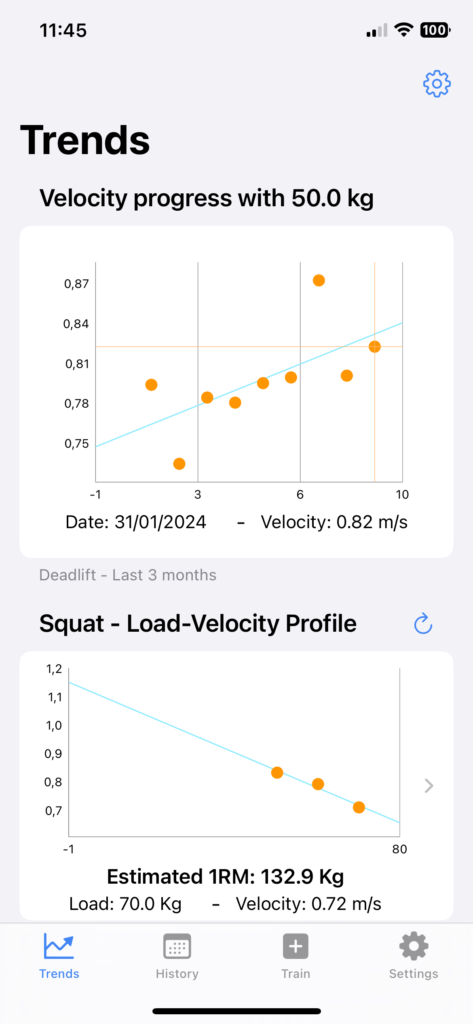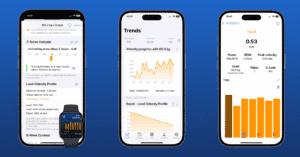Velocity-based training is not just lifting fast. It shows you if your training are going as planned. Let’s deep dive!
INTRODUCTION
Velocity-based resistance training offers us a multitude of advantages to improve our resistance training. The most well-known advantages are those related to real-time feedback and velocity loss control. However, controlling barbell velocity can also help us to control our performance in the long term. There are several methods of doing this:
One of the best known is to use each training session as if it were an evaluation session. That allows us to obtain metrics such as 1RM, load-velocity profile score… However, these methods, to be reliable, require training at maximum intentionality the whole spectrum of the load-velocity ratio each, i.e. from low loads to high loads. It can be useful if the warm-up is also monitored, but it requires consistency during most sessions.
Let me know in the comments if you would like to explore this further and if you would like Spleeft to have these analysis functions.
MANAGE LONG-TERM PERFORMANCE WITH SPLEEFT
Lot’s of people asking about power metrics: the problem with them is just barbell power (encoders and accelerometers) != system power (force platforms) THREAD👇
— Iván de Lucas Rogero (@Ivvy_dlr) October 24, 2022
Spleeft uses the monitoring of the fastest or most powerful repetition against the same load over time. This overcomes the problems of estimating 1RM by velocity: there is no need for a load-velocity profile and it is not contaminated by possible variations in the minimum velocity threshold (MVT or speed at which the 1RM is lifted). However, this method also has some disadvantages that coaches and athletes should be aware of:
– The athlete has some “tricks” to get to improve his velocity against a given load: decrease the range of motion past the stagnation point. Therefore, he/she will start the repetition with a better disposition of the muscle fibres to produce force. It will help him to reach a higher average velocity. You should take this into account when monitoring progress and eliminating this type of repetition.
– Although ROM is also taken into account, the power measured by the most accessible technologies (linear encoder, accelerometers) is the power of the bar, not the power of the system, as the calculation does not take into account the mass of the person. In upper body exercises only the mass of the arms is taken into account, so it is negligible. In lower body exercises it is more difficult to determine which part of the body a person lifts.
Keep all these considerations in mind when analysing your data. Remember that no metric is definitive and all have their strengths and weaknesses.
How does it work?
In the VBT history chart you can see this. As a summary of a training period, Spleeft will show you the fastest repetition with a given load over time. You can see the trend line too so you can easily see your progress.
Click on the settings icon (top right). Then you can change:
- The parameter you want to see on the chart: velocity or power.
- The time period of the fetched data.
- The exercise (as long as it has been performed in the selected period)
- And the weight you want to see.
The configuration of this graph serves for the graphs of the following screens.
MANAGING LONG-TERM PERFORMANCE WITH VELOCITY-BASED TRAINING: use cases.
Case 1: Positive trend of velocity/power.
Progressively improving velocity or power against the same load means that the athlete is acquiring the adaptations that the training plan was looking for, and that the dose is adequate. This is the trend we should be looking for.

Case 2: Stable trend.

Always moving the same load at the same velocity is a symptom that the training plan is not progressing. the training dose, in terms of volume (whether intra or inter sessions), is not sufficient to progress.
It may also indicate that, after a progressive improvement in velocity/power, the athlete is fully adapted to the load and has finished making progress. Therefore, after the metric, it stabilises.
At times of the season, in the case of competitive athletes, where it is only necessary to maintain strength levels after a period of searching for adaptations, this may be the trend to look for.
Case 3: Downward trend.

This trend should only concern you when seeking to maintain strength levels. Continuing with the previous example, on the maintenance of strength levels during the season, this change in trend is the one that should alarm us that the athlete is not achieving his goal and, therefore, we must increase the intensity somewhat to achieve it.
In the case of powerlifters, a positive adaptation is to get their 1RM up slower and slower, as they are able to recruit more muscles and spend more time applying force.
You can enjoy Spleeft here!





